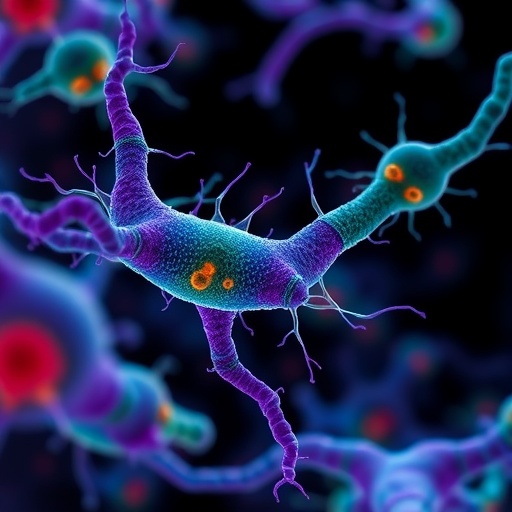In the dynamic microcosm of epithelial tissues, the carefully orchestrated balance between cell survival and elimination underpins the fundamental process of tissue homeostasis. A groundbreaking study published in Nature by Mitchell et al. has illuminated an energy-dependent mechanism that selectively extrudes live epithelial cells from crowded environments. This revelation challenges classical views that primarily ascribe cell death to mitochondrial permeabilization and apoptosis, proposing instead that energy deficiency marks cells for removal without immediate demise. The findings provide a fresh lens into the bioenergetic thresholds governing cellular fate and have far-reaching implications for understanding diseases characterized by altered tissue turnover.
Epithelial tissues serve as critical barriers and interfaces in organs such as the lungs and kidneys, maintaining homeostasis through consistent cell renewal. Historically, cell extrusion—a process removing cells from the epithelial layer—has been closely linked with apoptosis, where cellular demise is a prerequisite for extrusion. However, Mitchell and colleagues demonstrate that during homeostatic extrusion, cells are expelled while still metabolically viable, retaining sufficient energy to survive and reattach if transplanted onto a new substrate. This novel insight suggests a competitive energy-based decision mechanism that favors the elimination of cells exhibiting comparatively lower ATP levels relative to their neighbors.
Cellular energy status is integral to cellular function and viability. Neurons, with their high metabolic demands, expend up to 70% of their ATP maintaining membrane potentials. By contrast, epithelial cells, though less energetically demanding, allocate about a quarter of their ATP towards ionic balance and membrane integrity. This difference underscores that even small deviations in energy supply within epithelia can significantly influence cell behavior and fate. The current study leverages these bioenergetic nuances to propose an elegant selection system—cells with energy deficits are preferentially extruded to preserve tissue function and density.
A particularly intriguing aspect of this research lies in the mechanotransduction pathways that are hypothesized to link energy status with extrusion signals. Cell shrinkage emerges as a key morphological cue, yet its precise mechanism of activating extrusion machinery remains enigmatic. One compelling hypothesis is that shrinkage alters the level of physical crowding needed to stimulate the mechanosensitive cation channel Piezo1. By increasing the threshold for Piezo1 activation, cells undergoing contraction may dampen the constant mechanical “noise” from neighboring cells, thereby creating a clearer signal for extrusion initiation.
Supporting this mechanistic model, recent experiments noted that imposing an electric current across an epithelial monolayer drastically affects cell contractility and extrusion rates. Specifically, directing an apical-to-basal current leads to widespread contraction and extrusion, whereas a basal-to-apical current strengthens cell-cell junctions and facilitates repair. This polarity-dependent electrical modulation corroborates the idea that ionic gradients and membrane potentials are not merely passive indicators but active drivers influencing cell fate decisions in epithelia.
The role of ATP as an early and central determinant in extrusion also cements the concept that metabolic state governs epithelial cell turnover. ATP depletion selectively flags cells for removal while allowing them to retain sufficient energy for the extrusion process itself. This energy threshold model introduces a paradigm shift from viewing extrusion solely as a death-driven event to appreciating it as an energy-guided quality control. In the context of metabolic diseases, such as diabetes and cancer, where cellular energy metabolism is often dysregulated, disruptions in this delicate extrusion balance may contribute to pathology and impaired tissue renewal.
Ion channels emerge as crucial players in this tightly regulated extrusion pathway. Beyond Piezo1, several channels such as epithelial sodium channels (ENaC) and cystic fibrosis transmembrane conductance regulator (CFTR) chloride channels are implicated not only in extrusion but also in disease states marked by epithelial dysfunction. Mutations and misregulation of ENaC channels and voltage-gated potassium channels like K_v1.1 and K_v1.2 are linked with prognosis in diverse cancers, suggesting that ion homeostasis and extrusion mechanisms may intertwine with oncogenic processes and tumor microenvironments.
Further complexity arises considering the role of aquaporins—water channel proteins that may cooperate with ion channels to regulate cell volume and extrusion. Although their specific functions in the extrusion cascade remain to be elucidated, aquaporins represent another layer of cellular machinery potentially modulating epithelial turnover according to organ-specific demands. The authors suggest that epithelial tissues in the kidney and lung, known for their unique ion channel profiles, could utilize analogous extrusion mechanisms, highlighting a conserved yet adaptable system tuned for organ architecture and function.
From a broader physiological perspective, this research sheds new light on how membrane potential differentials within epithelia may create directional ionic currents that steer not only extrusion but also migration and patterning. Similar currents are documented in wound healing and organ development, implying that extrusion mechanisms could be part of a dynamic interplay between bioelectric signaling and cellular mechanics. This integration of electrophysiology with cell biology opens innovative avenues for therapeutic intervention targeting ion channels to modulate epithelial homeostasis.
Given the centrality of extrusion in epithelial cell turnover, disruptions in these processes could contribute significantly to disease. Channelopathies—conditions arising from ion channel dysfunction—may manifest through altered extrusion dynamics, leading to aberrant cell accumulation or loss. Such dysregulation might amplify the progression of cancers, chronic inflammatory diseases, and genetic disorders like cystic fibrosis. Understanding the energy-dependent extrusion mechanism paves the way for novel diagnostics and treatments that restore proper epithelial function via metabolic and ionic modulation.
The study by Mitchell et al. also raises compelling questions about the interplay between cellular mechanics, metabolism, and signaling. How exactly does cell shrinkage initiate Piezo1 activation and the downstream sphingosine-1-phosphate (S1P) signaling vesicles essential for extrusion? Could manipulation of ionic fluxes or metabolic regulators fine-tune extrusion rates therapeutically? These unknowns highlight the frontier of research where cell bioenergetics, mechanotransduction, and ion channel physiology converge.
This energy-centric model fundamentally challenges the traditional dogma that equates extrusion with imminent cell death. Instead, extrusion emerges as a dynamic, energy-governed response to cellular crowding and metabolic competition, ensuring that only the least fit cells are removed while preserving the viability of adjacent tissue. Such insight elevates the understanding of epithelial biology and situates energy metabolism at the core of cellular homeostasis and tissue integrity.
In summary, this innovative research uncovers the biochemical and biophysical underpinnings of homeostatic cell extrusion, emphasizing an energy deficiency threshold as a pivotal determinant for cell selection. The implications extend beyond basic science to translational medicine, offering a framework for interpreting how metabolic disruptions can perturb epithelial turnover in diseases. As the field advances, integrating energetic, mechanical, and ionic perspectives promises to revolutionize strategies for tissue repair, cancer treatment, and management of epithelial disorders.
Subject of Research:
The study investigates how energy deficiency within crowded epithelial cells drives the selective extrusion of live cells, highlighting ATP levels, membrane potential, and ion channels as critical regulators of epithelial cell turnover.
Article Title:
Energy deficiency selects crowded live epithelial cells for extrusion
Article References:
Mitchell, S.J., Pardo-Pastor, C., Tchoumakova, A. et al. Energy deficiency selects crowded live epithelial cells for extrusion. Nature (2025). https://doi.org/10.1038/s41586-025-09514-w
Image Credits:
AI Generated
Tags: ATP levels and cellular competitionbioenergetic thresholds in cellular fatecompetitive energy-based decision mechanismsenergy shortage and epithelial cell extrusionepithelial tissue barriers and interfacesimplications of energy deficiency in tissue turnovermechanisms of cell extrusion in crowded environmentsmetabolic viability of extruded epithelial cellsmitochondrial permeabilization and apoptosisorgan health and epithelial renewaltissue homeostasis and cell survivalunderstanding diseases related to altered cell turnover





